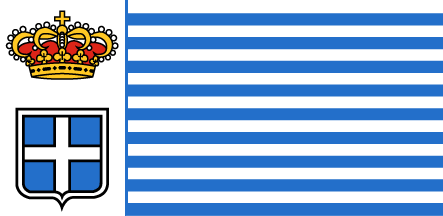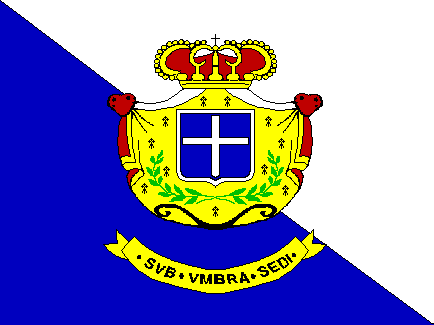
by Graham Bartram, 24 July 1997

Last modified: 2003-07-05 by dov gutterman
Keywords: seborga | italy | st. bernard | cross | crown | stripes |
Links: FOTW homepage |
search |
disclaimer and copyright |
write us |
mirrors

by Graham Bartram, 24 July 1997
See also:
Other Sites:
I have received the new flag of Seborga from the
Principalities Internet Office.
Graham Bartram, 24 July 1997
You can have informations about Seborga at <www.seborga.info>
.Regarding the flag and according to World Flag Database
maintained by Graham Bartram at <www.flags.net> the flag of
Seborga has been changed in1997.
Pascal Gross, 15 June 1998

by Zeljko Heimer, 3 April 1996
Belize has 'SUB UMBRA FLOREO', Seborga
'SVB VMBRA SEDI'. Also, the shape of the arms is strikingly
similar to the former royal arms of Serbia, Montenegro, Greece
and Italy.
Zeljko Heimer, 7 March 1996
The motto of Seborga is "sub umbra sedi" which
translates to "sit in the shade"!
The arms in the flag are derived from those of the order of St.
Bernard.
Graham Bartram, 24 July 1997
According to Roberto Breschi presantation titled: "The
Small Italian States Which Lasted Beyond 1700" at ICV 19
(York,2001), Until 1729 the flag in use was a diagonal divided
(upper hoist-low fly) blue over white, just like we got in above,
but without the arms.
Dov Gutterman, 2 August 2001
On 21 May 1995, the news programme 'ARD Weltspiegel' (German
television) reported from the 'indipendent Principato di Seborga'
at the foot of the Ligurian Alps in Italy (near the border with
France).At the end of April, the majority of the inhabitants (304
against 4) of this tiny village voted in favor of independence.
Jos Poels, 14 June 1995
Giorgio Carbone, the so-called "prince" of Seborga, claims the independence of that village, but it had been annexed by the Kingdom of Sardinia (ruled by the House of Savoia) on 20th January 1729. Before that date the village wasn't a Principality, but a feud of the Cistercian Order. The inhabitants might have voted for the independence in an illegal referendum made by Mr Carbone, but they still vote in the legal elections of the Republic of Italy, as demonstrated by at <www.parlamento.it> (in the ele